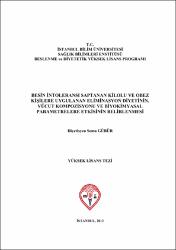Besin intoleransı saptanan kilolu ve obez kişilere uygulanan eliminasyon diyetinin, vücut kompozisyonu ve biyokimyasal parametrelere etkisinin belirlenmesi
Künye
Gübür, Sema. (2012). Besin İntoleransı Saptanan Kilolu Ve Obez Kişilere Uygulanan Eliminasyon Diyetinin, Vücut Kompozisyonu Ve Biyokimyasal Parametrelere Etkisinin Belirlenmesi. Yayımlanmamış yüksek lisans tezi. İstanbul : İstanbul Bilim Üniversitesi, Sağlık Bilimleri EnstitüsüÖzet
Besin intoleransı (Bİ), besinlere karşı immünolojik olmayan reaksiyonlar olup, gerçek besin allerjileriyle karıştırılır. Günlük beslenmede tüketilen her türlü besine intolerans, zamanla gelişebilir. Besin intoleransı görülme oranı, gıda allerjilerinden daha yaygındır. Yapılan çalışmalar, besin antijenlerine karşı oluşan gamma G immunoglobulin’in (IgG) obezite gelişiminde rol aldığı olasılığını yükseltmiştir. Besinlere karşı oluşan reaksiyonlarda, tedavide eliminasyon diyetinin önemi büyüktür.
Bu çalışmada besin intoleransı saptanan kilolu ve obez kişilere uygulanan eliminasyon diyeti ile birlikte kişiye özel zayıflatıcı diyetin, vücut kompozisyonu ve biyokimyasal parametrelere etkisi araştırılmıştır. Çalışma grubu, Şubat 2010-Mart 2011 yılları arasında Yorktest Türkiye Laboratuarı özel ofiste takip ve tedavi edilen, besin intoleransı tanısı alan, BKİ > 26kg/m2 olan 20 hastadan oluşmuştur. Bu hastaların antropometrik ölçümleri “Tanita BC-418 MA Body Composition Analyzer” ile yapılmıştır. Kişilerin el parmak uçlarından Lancet ile alınan kan örneklerinde, enzyme-linked immunosorbent assay (ELİSA) yöntemi ile, besinlere karşı reaksiyonları olup olmadığı belirlenmiştir. Yorktest Türkiye Laboratuvarı özel ofisin protokolünde yer alan biyokimyasal parametreler, eliminasyon diyeti + kişiye özel zayıflatıcı diyet uygulamasından önce ve sonra, iki kez olmak üzere özel bir laboratuarda analiz edilmiştir. Çalışmaya katılanların besin tüketim sıklıklarının belirlenmesinde, çalışmanın başlangıcında ve eliminasyon diyeti + kişiye özel zayıflatıcı diyet uygulaması sonunda, iki kez olmak üzere, Türkiye -PURE çalışması için özel olarak geliştirilen “Erişkin semi-kantitatif besin sıklığı anketi” kullanılmıştır.
Katılımcıların besin intoleransı testi sonuçlarına göre, en yüksek duyarlılığın maya, yumurta beyazı ve sarısı, kızılcık, inek sütü, tavuk eti, mercimek ve maydanoza karşı oluştuğu belirlenmiştir. Katılımcılara, uygulanan eliminasyon diyeti + kişiye özel zayıflatıcı diyet öncesi ve sonrası antropometrik ölçümler ve biyokimyasal parametrelerde istatistiki yönden anlamlı düzelmelerin olduğu belirlenmiştir.
Sonuç olarak; kilolu ve obez kişilere, eliminasyon diyeti + kişiye özel zayıflatıcı diyetlerin birlikte uygulanması ile oluşan vücut kompozisyonu ve biyokimyasal parametrelerdeki olumlu değişiklikler nedeniyle; bu diyetin obezitenin tıbbi beslenme tedavisinde, uygulanabilecek bir tedavi seçeneği olabileceğini düşünüyoruz. Food Intolerance, is a reaction against food, but not immunological manner, and may be confused with real food allergies. Food intolerance may be developed to each food in our daily nutrition in the course of time. Frequency of food intolerance is more prevailing than food allergies. Studies executed scale probability up of gamma G immunoglobulin (IgG), which occurs against food antigens; to obesity development. Elimination diet has an important role in food intolerance treatments.
In this study, effects of special weight-loss diet together with an elimination diet to body composition and biochemical parameters of overweight and obese persons who diagnosed with food intolerance were investigated. The workgroup consists total 20 patients, who are followed-up and treated in Yorktest Turkey Laboratory between February 2010 and March 2011, diagnosed with food intolerance, and whose BMI was > 26kg/m2.. Anthropometric measures of these patients were executed with Tanita BC-418 MA Body Composition Analyzer. Bloodletting for these patients is executed with Lancet from their fingertips, and blood drawn from these patients is assessed via enzyme-linked immunosorbent assay (ELİSA) method, and food reactions of patients are determined for each food. Biochemical parameters of these patients are routine tests, which are necessary for food intolerance tests and analyzed in Yorktest Turkey Laboratory as two times: before and after elimination diet plus special weight-loss diet. In the initial period of the study, and also at the end of elimination diet plus special weight-loss diet, “Adult semi-quantitative food frequency questionnaire”, which is developed for “Prospective Urban Rural Epidemiology Study” (PURE) was used as two times, in order to determine food consumption frequency of these patients.
It has been determined that, the most common sensivity is obtained against the yeast, egg yolk and white, cranberry, cow milk, chicken meat, lentil and parsley. Anthropometric measurements and biochemical parameters before and after elimination diet plus special weight-loss diet applied to participants, were significantly improved in statistical manner.
As a conclusion, due to positive changes in body composition and bio-chemical parameters obtained through application of special weight-loss diets together with elimination diet applied to fat and obese persons, we think that this diet might be used for medical nutrition treatment of obesity as a treatment option.


















